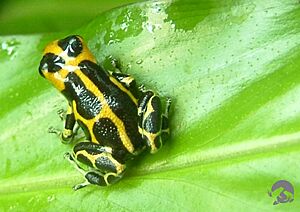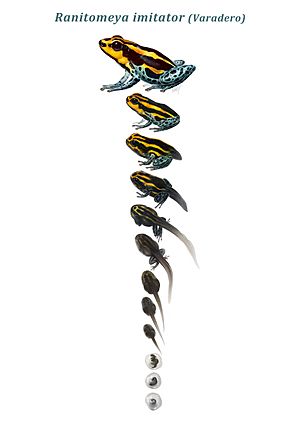Mimic poison frog facts for kids
Quick facts for kids Mimic poison frog |
|
|---|---|
 |
|
| Conservation status | |
| Scientific classification | |
| Genus: |
Ranitomeya
|
| Species: |
imitator
|
| Synonyms | |
|
Dendrobates imitator Schulte, 1986 |
|
The Ranitomeya imitator, also known as the mimic poison frog or poison arrow frog, is a type of poison dart frog. You can find it in the north-central part of eastern Peru. This frog is very well-known among dart frogs. It was discovered in the late 1980s by Rainer Schulte. He later found that there were different kinds of this frog, each with a special color and sometimes different behaviors. Scientists have studied a lot about how these frogs look, sound, and act.
Contents
Amazing Colors and Mimicry
R. imitator frogs come in many different colors. They use these colors to look like other poison frog species that live in the same area. This is called Müllerian mimicry, where a harmless animal looks like a dangerous one to scare off predators. There are four main color types, or "morphs," of R. imitator that copy other frogs:
- Varadero: This morph looks like R. fantastica.
- Striped: This one mimics the striped Ranitomeya variabilis found in lower areas.
- Spotted: This morph copies the spotted R. variabilis from higher areas. It's usually blue-green, but can also be yellow.
- Banded: This morph looks like Ranitomeya summersi.
These different color types usually live in separate parts of Peru. However, there are some "transition zones" where different morphs meet and interact. The striped morph is the most common. Even though R. imitator looks a lot like R. variabilis, they are different in important ways. R. imitator parents both take care of their young and stay together (monogamous). R. variabilis fathers only care for the young, and they have many partners (polygamous). The banded morph lives in drier places than other R. imitator frogs. You can often find them in plants like Dieffenbachia and Heliconia.
How Different Color Morphs Interact
When different color morphs meet in "transition zones," scientists get a chance to study how new species might form. Recent studies suggest that the frog's color pattern is very important in deciding who mates with whom. In these zones, frogs often prefer to mate with others that have the same color pattern. This is called assortative mating. Male frogs make mating calls to attract females. While the calls of different R. imitator morphs are similar, it seems their color is the main thing that helps them find a mate of their own kind.
Froggy Defenses: Toxicity
Like most other Ranitomeya frogs, R. imitator has a mild poison compared to some other poison dart frogs. It produces a strong toxin called pumiliotoxin B. But because these frogs are small, they don't have a lot of poison. When kept as pets, these frogs do not produce toxins. This is because they get their poison from eating certain toxic insects or other small creatures in the wild. For example, some related frogs get their toxins from specific beetles.
Reproduction and Parental Care
Scientists are very interested in how R. imitator frogs reproduce and care for their young. This frog is special because it was the first amphibian found to be monogamous, meaning a male and female stay together. It also developed biparental care, where both parents help raise the young. This supports the idea that when both parents help, it can lead to monogamy. The care provided by both R. imitator parents is very important for their babies to grow and survive.
Courtship and Laying Eggs
To find a mate, male frogs will call out while moving closer to a female. If the female likes him, she will follow him to a spot where they will mate. She then lays fertilized eggs on a plant. The eggs will develop there. Not many tadpoles successfully hatch and make it to a water pool. One study found only 1 to 4 tadpoles per mated pair.
Male Parental Care
After the eggs are laid, the male frog guards them. Once the tadpoles hatch, the male carries each one to its own small pool of water found in plants, called a phytotelma. The male is smart about where he puts the tadpoles, making sure to avoid places with predators. After the tadpoles are in their pools, the male will call while next to them. This signal tells the mother to feed that specific tadpole. Tadpoles can also wiggle their bodies, which encourages the mother to give them special food eggs.
Female Parental Care
Female frogs provide care by feeding their offspring special unfertilized eggs. After mating, the female has extra eggs. She gives these eggs to her babies as food. This food helps the young tadpoles grow and develop. This type of biparental care is common in some poison frogs. Researchers have found that poison frogs that use plant pools to raise their young are more likely to feed them eggs. This combination helps biparental care develop in these species. How hormones control this parental care is still being studied.
Keeping Ranitomeya imitator
Compared to many other dart frog species, Ranitomeya imitator has fairly large and stable populations in the wild. However, they are sometimes illegally collected and taken out of the country. They have also been brought in legally, and many captive-bred types exist in the pet trade.




